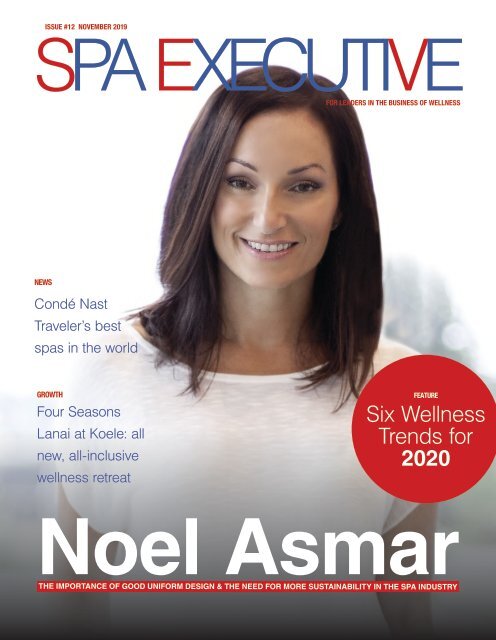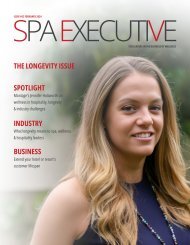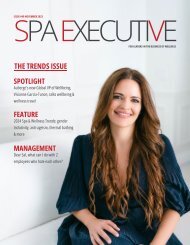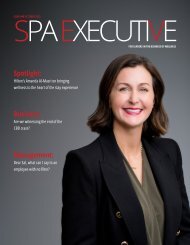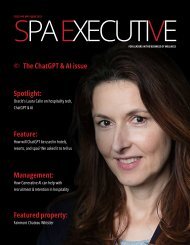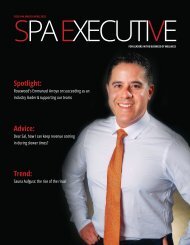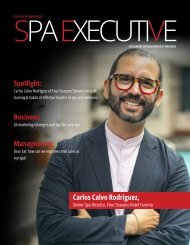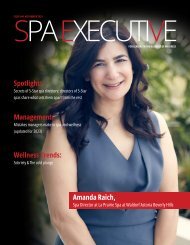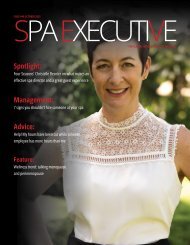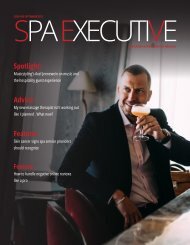Spa Executive | Issue 12 | November 2019
You also want an ePaper? Increase the reach of your titles
YUMPU automatically turns print PDFs into web optimized ePapers that Google loves.
ISSUE #<strong>12</strong> NOVEMBER <strong>2019</strong><br />
SPA EXECUTIVE<br />
FOR LEADERS IN THE BUSINESS OF WELLNESS<br />
NEWS<br />
Condé Nast<br />
Traveler’s best<br />
spas in the world<br />
GROWTH<br />
Four Seasons<br />
Lanai at Koele: all<br />
new, all-inclusive<br />
wellness retreat<br />
FEATURE<br />
Six Wellness<br />
Trends for<br />
2020<br />
Noel Asmar<br />
THE IMPORTANCE OF GOOD UNIFORM DESIGN & THE NEED FOR MORE SUSTAINABILITY IN THE SPA INDUSTRY
PUBLISHER<br />
Roger Sholanki<br />
EDITOR<br />
Elizabeth Bromstein<br />
DESIGNER<br />
Shajee Aijazi<br />
Note from the Publisher<br />
<strong>Spa</strong> and wellness is going through a great evolution right now, and it feels like the speed at<br />
which this is happening keeps increasing. Technologies and ideas that were just recently in their<br />
infancy are suddenly maturing and taking on exciting new forms with the potential to change our<br />
world as we know it.<br />
Take Noel Asmar’s sustainable spa uniforms made from recycled plastic that recently won the<br />
ISPA Innovation of the Year award. This simple but brilliant idea not only creates a solution to<br />
the waste problem, it brings sustainability to the forefront -- something spa and wellness<br />
desperately needs to do. Asmar, who is in our <strong>Spa</strong> <strong>Executive</strong> Spotlight this month, has also<br />
launched her new Hospitality Lifecycle initiative, which provides hotels and spas with access to<br />
practical, cost-effective solutions to safely and securely dispose of used textiles. These are just a<br />
couple of examples of how sustainability initiatives are maturing.<br />
In this issue of <strong>Spa</strong> <strong>Executive</strong> we also list our spa and wellness trend predictions for 2020.<br />
Among these you’ll find more examples of the sort of innovative thinking combined with scientific<br />
discovery, creativity, and technological advancement that make this such an exhilarating time for<br />
us. These include, but aren’t limited to, the use of psychobiotics to potentially revolutionize the<br />
way we see mental health; clothing that can monitor and improve our wellbeing; and more<br />
movement towards cleaning up our planet, holding businesses accountable, and demanding<br />
transparency.<br />
Only time will tell if we were right in our trend forecasts, and in the meantime I’ll be content to be<br />
humbled and amazed by people’s ingenuity and curiosity.<br />
<strong>Spa</strong> <strong>Executive</strong><br />
The online magazine for <strong>Spa</strong><br />
<strong>Executive</strong>s, featuring news<br />
and exclusive interviews.<br />
I hope you’re similarly excited.<br />
Roger Sholanki,<br />
CEO, Book4Time
Contents<br />
<strong>November</strong> <strong>2019</strong> Volume <strong>12</strong><br />
3<br />
NEWS<br />
Mud and mineral baths<br />
potentially viable natural<br />
treatments for osteoarthritis.<br />
3<br />
5<br />
NEWS<br />
Condé Nast Traveler’s best<br />
spas in the world<br />
7<br />
TRENDS<br />
Psychobiotics: the wellness<br />
trend you need to know about<br />
9<br />
BUSINESS<br />
10 questions to ask in a<br />
customer satisfaction survey<br />
11<br />
GROWTH<br />
Four Seasons Lanai at Koele: all<br />
new, all-inclusive wellness retreat<br />
15<br />
15<br />
SPOTLIGHT<br />
Noel Asmar on the importance<br />
of good uniform design & the<br />
need for more sustainability in<br />
the spa industry<br />
19<br />
TECHNOLOGY<br />
Skin II: fabric with probiotic<br />
technology for healthier skin<br />
21<br />
FEATURE<br />
Six spa & wellness trends for<br />
2020<br />
5 11
Mud and mineral water<br />
baths are natural treatments<br />
for Osteoarthritis<br />
Mud and mineral baths have been found to be potentially<br />
viable natural treatments for osteoarthritis.<br />
A study by a group of Lithuanian researchers has found that<br />
hot mud treatments and sodium chloride mineral baths may<br />
relieve the symptoms of osteoarthritis.<br />
OA is the most common articular disease in the world<br />
According to Medical News Today, Osteoarthritis (OA) is a<br />
degenerative disease that causes pain and stiffness in the<br />
joints, most commonly affecting the knees, hips, and hands.<br />
OA is the most common articular disease in the world and<br />
affects more than 20 million people, including 10% of men<br />
and 13% of women aged 60 and older, in the United States,<br />
alone.<br />
The current first line of treatment is a combination therapy<br />
that includes pain medication and non-pharmaceutical<br />
treatments like physical and occupational therapy. OA can’t<br />
be reversed but treatments can reduce pain, slow the<br />
progress of the disease and improve movement.<br />
Mud, minerals are less expensive, drug free interventions<br />
The new study examines peloid therapy and balneotherapy<br />
as potentially less expensive and drug-free interventions.<br />
The first is the use of clay or mud to ease symptoms and the<br />
second is the practice of immersing the body in mineral rich<br />
water or mud. The findings were published in the<br />
International Journal of Biometeorology.<br />
The researchers wrote, “The treatment of OA using<br />
pharmaceutical and non-pharmaceutical measures remains<br />
a topical subject. The purpose of this study is to assess the<br />
effect of natural factors (mineral water and mud) on<br />
changes in the functional state of patients with knee joint<br />
OA.”<br />
Ninety-two participants – aged an average 64.6 years –<br />
were involved in the study, with females representing 87%<br />
of the group. All participants had low to moderate knee-joint<br />
OA and their symptoms were graded on a variety of physical<br />
measures, including walking speed, range of motion and<br />
extension, and the speed with they could sit down and<br />
stand up five times. Subjects were divided into three<br />
groups. Over the course of one month, all groups received<br />
physical therapy every other day, while the first group also<br />
received mineral water baths, the second received mud<br />
application procedures, and the third received physical<br />
therapy alone.<br />
The researchers found significantly greater improvement in<br />
levels of stiffness, pain, and physical activity in the groups<br />
that received either water or mud treatments combined with<br />
the physical therapy than in the group that received<br />
physical therapy alone. Symptoms were also better one<br />
month later in the intervention groups than in the control<br />
group.<br />
Improved pain and functional state<br />
They wrote, “Balneotherapy and peloid therapy effectively<br />
reduce pain and improve the functional state of patients<br />
with OA of a knee joint.”<br />
Previous research has found that mineral water baths show<br />
advantages in reducing pain and improving functional state<br />
compared with freshwater baths, and that mud therapy<br />
significantly reduced pain, stiffness and improved<br />
functional state.<br />
The researchers say future randomized controlled studies,<br />
and larger studies, are needed to confirm their results.<br />
Be sure to keep your guests informed about the latest<br />
research on treatments commonly available at spas and<br />
wellness retreats that may ease their symptoms.<br />
03 | <strong>Spa</strong> <strong>Executive</strong>
News<br />
<strong>Spa</strong> <strong>Executive</strong> | 04
CONDÉ NAST TRAVELER’S<br />
BEST SPAS IN THE WORLD<br />
<strong>2019</strong> READERS' CHOICE<br />
Condé Nast Traveler recently announced the winners of its annual Readers’ Choice Awards, ranking the best hotels, resorts, destination<br />
spas, countries, cities, islands, trains, airlines, airports, and cruise lines in the world.<br />
It’s the company’s first year as one global brand, and Condé Nast Traveler combined the annual surveys conducted in the U.S. and U.K.<br />
into one global Readers’ Choice Awards list. Collectively, the company received a recording-breaking number of responses from more<br />
than 600,000 readers who rated their travel experiences.<br />
“The way we travel today has changed significantly, and we know that is front and center in people’s desires and conversations,” said<br />
Melinda Stevens, editor-in-chief of Condé Nast Traveler. “As our readers continue to explore, we continue to listen. Our readers’ curiosity<br />
shapes our inspiration and ultimately our next adventure, and based on this year’s list, we’ll be making plenty of new discoveries.”<br />
The top spa on the list was Ananda in the Himalayas, in Narendra Nagar, Uttarakhand, India, with a rating of 99.6, followed by Lake<br />
Austin <strong>Spa</strong> Resort with a rating of 98.95.<br />
Read on for the list of Condé Nast Traveler’s top 30 spas in the world and their reader ratings.<br />
05 | <strong>Spa</strong> <strong>Executive</strong> News
CONDÉ NAST TRAVELER’S TOP 30 SPAS IN THE WORLD<br />
1. Ananda in the Himalayas<br />
Narendra Nagar, Uttarakhand, India (99.6)<br />
16. Lefay Resort & <strong>Spa</strong> Lago di Garda<br />
Gargnano, Italy (96.78)<br />
2. Lake Austin <strong>Spa</strong> Resort<br />
Austin, Texas, United States (98.95)<br />
17. Miraval Arizona Resort & <strong>Spa</strong><br />
Tucson, Arizona, United States (96.41)<br />
3. Vila Vita Parc<br />
Alporchinhos, Porches, Portugal (98.95)<br />
18. Mountain Trek Fitness Retreat & Health <strong>Spa</strong><br />
Ainsworth Hot Springs, British Columbia, Canada (95.89)<br />
4. Six Senses Zil Pasyon<br />
Seychelles, France (98.96)<br />
19. Kamalaya Wellness Sanctuary & Holistic <strong>Spa</strong><br />
Koh Samui, Thailand (95.59)<br />
5. The Ranch Malibu<br />
Malibu, California, United States (98.74)<br />
20. Mii Amo<br />
Sedona, Arizona, United States (95.58)<br />
6. Place Merano Espace Henri Chenot<br />
Merano, Italy (97.86)<br />
21. Brenners Park – Hotel & <strong>Spa</strong><br />
Baden-Baden, Germany (95.45)<br />
7. Grand Resort Bad Ragaz<br />
Bad Ragaz, Switzerland (97.7)<br />
22. VIVAMAYR Altausee <strong>Spa</strong><br />
Altausee, Austria (95.29)<br />
8. Schloss Elmau<br />
Krün, Germany (97.6)<br />
23. SHA Wellness Clinic Resort<br />
Alicante, <strong>Spa</strong>in (95.2)<br />
9. Lanserhof Tegernsee<br />
Waakirchen, Germany (97.52)<br />
24. COMO Shambhala Estate<br />
Bali, Indonesia (95.2)<br />
10. Cal-a-Vie, Vista<br />
California, United States (97.46)<br />
25. Canyon Ranch in Tucson<br />
Tucson, Arizona, United States (95.19)<br />
11. Aro Hā Wellness Retreat<br />
Glenorchy, South Island, New Zealand (97.45)<br />
26. BodyHoliday<br />
Cariblue Beach, St. Lucia (95.15)<br />
<strong>12</strong>. Golden Door<br />
Escondido, California, United States (97.27)<br />
27. Euphoria Retreat<br />
Mystras, Greece (95.15)<br />
13. Six Senses Douro Valley<br />
Douro Valley, Portugal (97.06)<br />
28. Chiva-Som International Health Resort<br />
Hua Hin, Thailand (95.03)<br />
14. The Lodge at Woodloch<br />
Hawley, Pennsylvania, United States (96.9)<br />
29. Les Sources de Caudalie<br />
Bordeaux, France (95)<br />
15. Rancho La Puerta<br />
Tecate, Baja California, Mexico (96.78)<br />
30. Vana<br />
Dehradun, Uttarakhand, India (95)<br />
Of nearly 10,000 hotels, resorts, and destination spas rated, barely 15% made the cut.<br />
The <strong>2019</strong> winners are prominently featured on Condé Nast Traveler’s website and celebrated in the <strong>November</strong> issue on newsstands<br />
nationwide Oct. 8.<br />
News<br />
<strong>Spa</strong> <strong>Executive</strong> | 06
PSYCHOBIOTICS<br />
The wellness trend you need to know about<br />
You’ve heard of probiotics and prebiotics,<br />
and may already be taking them. Have<br />
you heard of psychobiotics? These<br />
bacteria that may have a mental health<br />
benefit when ingested should be of<br />
interest for those in the spas and wellness<br />
sector with any focus on mental health<br />
and wellness.<br />
“No area of psychiatry is as hot today…”<br />
The idea that the trillions of bacteria in our<br />
guts (a.k.a. our gut microbiota) could have<br />
a drastic affect on our mental health is not<br />
a new one, but until recently it was still<br />
considered somewhat fringe. Now it’s<br />
gaining in popularity and credibility with a<br />
growing body of research, though more is<br />
still required for the scientific community<br />
to come to any kind of consensus.<br />
Canada’s National Post recently stated<br />
“No area of psychiatry is as hot, or<br />
controversial today as the idea of<br />
manipulating the gut to alter the mind.”<br />
The Post article also states that<br />
gastro-intestinal problems are common in<br />
people with anxiety and depression. And<br />
it has been demonstrated that certain<br />
probiotics are associated with improved<br />
mood. This is where psychobiotics come<br />
in.<br />
Gut problems can lead to anguish,<br />
psychosis and anxiety<br />
One proponent of the gut-brain<br />
connection and psychobiotics is Scott<br />
Anderson, co author of the The<br />
Psychobiotic Revolution: Mood, Food, and<br />
the New Science of the Gut-Brain<br />
Connection, with Ted Dinan and Jon<br />
Cryan of the APC Microbiome Institute at<br />
University College Cork. While allowing<br />
that not every mental health issue is gut<br />
related, Anderson stated in a recent<br />
Psychology Today article that many of our<br />
mental issues start in the gut and that<br />
“we’ve known for centuries that gut<br />
problems can lead to mental anguish,<br />
psychosis, and anxiety.”<br />
Anderson calls these microbes “the royal<br />
guards of immunity,” stating that they<br />
fight and destroy pathogens before those<br />
pathogens can make it to the immune<br />
system. However, he writes, “if you don’t<br />
feed your guardian microbes properly,<br />
they won’t be able to mount an effective<br />
counterattack. If pathogens are able to<br />
gain a foothold, they can disturb the lining<br />
of your gut. That lining is one cell thick, a<br />
ridiculously thin barrier against<br />
troublemakers. Pathogens can burrow<br />
and dig into this lining, allowing toxins or<br />
bacteria to leak into your bloodstream.<br />
Your heart obligingly pumps those<br />
potential poisons to every organ in your<br />
body, including your brain.”<br />
Areas of interest include fermented foods<br />
and fecal transplants<br />
This area of study has led to heightened<br />
interest in pro and pre biotics, fermented<br />
foods, and fecal pills and transplants. The<br />
transplants, which involve transplanting<br />
feces from one body into another, have a<br />
near 100% success rate in curing<br />
antibiotic-resistant superbug Clostridium<br />
difficile and are currently being tested in<br />
people with depression and bipolar<br />
disorder by researchers at the University<br />
of Calgary. The hope, according to the<br />
National Post, is that enhancing good gut<br />
microbes may be a viable treatment for<br />
drugs resistant depression. This research,<br />
Valerie Taylor, chief of psychiatry at the<br />
University of Calgary, told the Post, may<br />
change our entire concept of mental<br />
illness. “We now think mental illness is<br />
essentially a brain illness, and it may be<br />
that it isn’t,” Taylor said.<br />
The mechanism behind the connection<br />
isn’t clear, but Taylor told the Post that it’s<br />
possibly due to stress causing<br />
inflammation, which is connected to gut<br />
dysbiosis, which has been linked with<br />
altered brain function.<br />
07 | <strong>Spa</strong> <strong>Executive</strong> Trends
Psychobiotic food pyramid<br />
In a more practical, day to day application, Scott Anderson has also<br />
developed a “psychobiotic food pyramid,” a new version of the famous<br />
diagrams published around the world as healthy eating guidelines, with<br />
foods one should be eating most on the bottom and least at the top.<br />
Anderson’s pyramid prioritizes high fiber vegetables, whole grains, and<br />
nuts and olive oil. Fish and seafood and fermented foods should be<br />
consumed often, he says, followed by poultry, eggs and dairy. Sugar and<br />
red meat should be limited to once a week or less.<br />
World’s first psychobiotic food supplement<br />
Meanwhile, the “world’s first psychobiotic food supplement” recently<br />
went on the market in the UK.<br />
While the scientific community appears to be cautiously excited about<br />
these new developments, we’ll likely be seeing an increase in attention to<br />
this area in spa and wellness.<br />
Trends<br />
<strong>Spa</strong> <strong>Executive</strong> | 08
QUESTIONS TO ASK IN A CUSTOMER<br />
SATISFACTION SURVEY<br />
customer satisfaction survey is a key element of spa business success. Some people balk at<br />
the idea of soliciting feedback – I once heard a manager refer to the idea of sending a survey as<br />
10The<br />
“crazy” – but you should do it.<br />
The only way to know if your customers are happy is to ask them<br />
If you want to know if your customers are happy, you have to ask. A vast majority of people will not<br />
complain after a negative experience with a brand; they just won’t go back. (Think about it. Do you<br />
complain every time you’re dissatisfied with a product or service? Or do you just write off the<br />
business and look elsewhere?) And an experience doesn’t necessarily have to be negative in order<br />
for a customer to not return. In many cases it just has to be “not great,” which is pretty much<br />
interchangeable with “not bad.” Of course, you don’t want a “not bad” rating. You want a rating of<br />
“excellent” or its equivalent. And the only way to know if you’re hitting that target is to ask. A<br />
customer satisfaction survey is the way to do this.<br />
Surveys are opportunities for retention and acquisition<br />
Surveys are also an opportunity to work on customer retention and acquisition – if a spa guest is<br />
dissatisfied with their experience, you have the chance to make amends and try to keep them as a<br />
customer. If a guest is thrilled with their experience, you can ask for a referral or review. Customer<br />
satisfaction surveys also tell you where you need to improve.<br />
These surveys can be sent through your spa management software.<br />
09 | <strong>Spa</strong> <strong>Executive</strong> Marketing
Here are a few tips for sending a survey that<br />
people will complete:<br />
1. Provide an incentive. Offer a gift or discount<br />
for taking the survey. Why should anyone invest<br />
their time otherwise?<br />
2. Keep it short. People are busy and they do<br />
not want to spend more than a few minutes on<br />
your survey.<br />
3. Stick to the point. If it’s a customer<br />
satisfaction survey, stick to that. It can be<br />
tempting to add extra questions in an attempt to<br />
get more information and expand your scope,<br />
like “What other products would you like to see<br />
in our retail store?” or “How many spas did you<br />
contact before making an appointment with<br />
us?” but those questions are for another time.<br />
Keep it short or you risk respondents<br />
abandoning the survey.<br />
Don’t leave loose ends<br />
Do include the comment box. There may be<br />
something the guest would like to discuss<br />
with you that they didn’t want to complain<br />
about at the time. They might think “Well,<br />
OK. I’ll tell you. Since you asked…”<br />
I’ve have done this, myself; not complained<br />
at the time of an unpleasant customer<br />
service incident but later said something<br />
when asked in a survey.<br />
If there is a complaint, do follow up and<br />
make amends. This is your chance to win<br />
back a customer you would otherwise have<br />
lost. The incident I just mentioned was with<br />
a hotel. They followed up with an apology, a<br />
$50 gift card, and a pair of socks for my<br />
daughter. This was a nice surprise and I<br />
have since spent far more than the value of<br />
the gift card and socks with this company.<br />
Everyone won.<br />
Questions to ask in a customer satisfaction survey<br />
Now, here’s a list of questions to ask in customer experience survey that can<br />
help you get the information you’re looking for.<br />
When booking your appointment was the experience simple and intuitive?<br />
Yes<br />
No<br />
How did you book your appointment?<br />
Online Mobile Phone In person<br />
Other<br />
On a scale of 1 – 5, with 5 being excellent and 1 being terrible, how<br />
would you rate your experience with our front desk staff?<br />
Did your appointment start on time?<br />
Yes<br />
No<br />
Who was/were your service provider(s)?<br />
What services did you have?<br />
Did you feel that your service provider(s) was/were knowledgeable<br />
and professional?<br />
Yes<br />
No<br />
On a scale of 1 – 5, with 5 being excellent and 1 being terrible, how<br />
satisfied are you with your experience in our spa?<br />
On a scale of 1 – 5, with 5 being very likely and 1 being not at all<br />
likely, how likely are you to recommend us to friends and family?<br />
What else would you like us to know?<br />
Don’t leave loose ends and your bottom line<br />
will reflect that. Ask and you shall receive<br />
the information you need.<br />
Business<br />
<strong>Spa</strong> <strong>Executive</strong> | 10
Four Seasons Lanai<br />
at Koele<br />
All new, all-inclusive wellness retreat<br />
Four Seasons Hotels and Resorts has partnered with wellbeing<br />
company Sensei to create Four Seasons Hotel Lanai at Koele, A Sensei<br />
Retreat, which opens <strong>November</strong> 1, <strong>2019</strong>.<br />
The all-inclusive hotel will focus exclusively on wellness retreats, and<br />
offer a comprehensive and fully customizable program tailored to the<br />
needs of individual guests. The concept is unique to the Hawaiian<br />
market and a Four Seasons first.<br />
“Four Seasons partnership with Sensei signals our deep understanding<br />
of what today’s luxury traveller wants: an exclusive and differentiated<br />
wellness travel experience, perfectly pairing Sensei’s evidence-based<br />
approach to healthy living with Four Seasons renowned and legendary<br />
service,” says Christian Clerc, President, Global Operations, Four<br />
Seasons Hotels and Resorts, in a media release. “Set against the<br />
backdrop of the uniquely breathtaking Lanai landscape, this new<br />
offering combines unmatched hospitality, nutritious upscale dining and<br />
reputable experts to offer a luxury wellness experience found nowhere<br />
else in the world.”<br />
11 | <strong>Spa</strong> <strong>Executive</strong> Growth
Growth<br />
<strong>Spa</strong> <strong>Executive</strong> | <strong>12</strong>
The retreat sits on 90,000 acres of land in a picturesque<br />
setting with a backdrop of towering Cook pines and banyan<br />
trees on the island of Lanai, which is also home to the<br />
beachfront Four Seasons Resort Lanai. The Hotel includes a<br />
Great Room, Sensei by Nobu restaurant, spa and wellness<br />
facilities including 10 private spa hale (“houses” or<br />
“buildings”), and 96 guest rooms and suites.<br />
Four seasons and Sensei have enlisted a handpicked team<br />
of wellness experts, nutritionists, chefs, fitness experts, spa<br />
therapists and hospitality professionals to bring the wellness<br />
concept into being. Upon booking a retreat, each guest is<br />
matched with their own Sensei Guide to help customize their<br />
itinerary in advance. During each stay, the Sensei Guide<br />
adjusts the guest’s program according to that person’s<br />
needs.<br />
“Whether that’s targeting a specific<br />
health goal or simply unwinding from<br />
the stresses of everyday life, each<br />
itinerary is designed to be fluid and<br />
adaptable throughout their<br />
wellness-oriented vacation.”<br />
Sensei was co-founded by Larry Ellison, co-founder and<br />
CTO of Oracle Corporation, and Dr. David Agus. Agus is a<br />
professor of medicine and engineering at the University of<br />
Southern California Keck School of Medicine and Viterbi<br />
School of Engineering and the founding director of USC’s<br />
Lawrence J. Ellison Institute for Transformative Medicine. He<br />
is the author of best-selling books on data-driven<br />
approaches to a longer life.<br />
Agus said in a statement, “Our goal is to create experiences,<br />
products and services that help people address the gap<br />
between their wellness intentions and daily practices. Our<br />
retreat provides a great environment to work towards<br />
balance, health and well-being with the support of a<br />
dedicated, data-driven wellness team.”<br />
Activities on offer include one-on-one training sessions and<br />
group classes, lectures, philanthropic activities, immersive<br />
spa treatments, island excursions, horseback riding, sports,<br />
and more.<br />
13 | <strong>Spa</strong> <strong>Executive</strong> Growth
<strong>Spa</strong> <strong>Executive</strong><br />
FOR LEADERS IN THE BUSINESS OF WELLNESS<br />
ADVERTISE WITH US<br />
CLICK HERE FOR MORE DETAILS<br />
info@spaexecutive.com | www.spaexecutive.com
15 | <strong>Spa</strong> <strong>Executive</strong> Spotlight
NOEL ASMAR<br />
The Importance of Good Uniform Design & the Need for<br />
More Sustainability in the <strong>Spa</strong> Industry<br />
Noel Asmar is the CEO and founder of Noel<br />
Asmar Group Inc., the lifestyle brand behind<br />
Noel Asmar Uniforms, Pedicure Bowls and<br />
Asmar Equestrian.<br />
The Canadian designer is renowned for<br />
reinventing the spa uniform nearly 20 years<br />
ago and setting the standard for next<br />
generation uniform concepts in the spa and<br />
hotel industries. The company’s history goes<br />
back to 2002, when Ms. Asmar created the<br />
first designer spa uniform. The goal was to<br />
create an alternative to the “utilitarian and<br />
unflattering” uniforms to which the industry<br />
had grown accustomed, and to elevate the<br />
look and feel for a growing industry.<br />
Companies readily embraced Asmar’s design<br />
concepts, and a brand was born.<br />
Ms. Asmar has sat on the ISPA Board of<br />
Directors and is the recent recipient of the<br />
<strong>2019</strong> ISPA Innovation of the Year Award for<br />
her sustainable uniforms made from recycled<br />
plastic. She has also been recognized as one<br />
of Canada’s Top 20 Female Entrepreneurs.<br />
More recently, Noel Asmar Group launched<br />
Hospitality Lifecycle, an initiative to provide<br />
hotels and spas access to practical,<br />
cost-effective solutions to safely and securely<br />
dispose of used textiles.<br />
<strong>Spa</strong> <strong>Executive</strong> spoke with Noel Asmar about<br />
the importance of good uniform design, the<br />
Hospitality Lifecycle Initiative, and the need<br />
for more sustainability in the industry.<br />
Can you tell us a bit about your career<br />
path and how you came to be where you<br />
are today?<br />
With a love for animals and an equally strong<br />
passion for other cultures, languages and<br />
cuisine, I chose hotel management school<br />
over being a Veterinarian. I worked overseas<br />
in hotel management and then as Business<br />
Development Director for a marketing firm,<br />
where I spent time in Asia. There I was lured<br />
into the fabric markets to discover that I really<br />
enjoyed the process of fabric sourcing,<br />
sketching, and creating designs. I used my<br />
evenings and off time to design pieces for<br />
friends and family and created a small<br />
collection that would lay the foundation for<br />
my first start-up.<br />
While on a trip home to Vancouver to visit my<br />
mom (a nurse) and sister (an aesthetician), I<br />
realized their uniform options were boxy and<br />
unflattering, and that this applied to spa<br />
uniforms in general. I started sourcing fabrics<br />
and made my first proto-type – the Zen Tunic.<br />
I bought my first URL www.<strong>Spa</strong>Uniforms.com<br />
and built the first <strong>Spa</strong> Uniform Ecommerce<br />
site, shipping anywhere in the world, in Dec<br />
2002. Fast forward 17 years, we specialize in<br />
<strong>Spa</strong> & Hospitality, and rebranded to Noel<br />
Asmar Uniforms to expand our offerings into<br />
other areas within spas and hotels. Our first<br />
big hotel opening was City Center Las Vegas<br />
– Aria & Vdara.<br />
Why is uniform design important? Why<br />
did you feel the need to change the<br />
aesthetic?<br />
The uniform is the single most personal way<br />
to touch an employee – literally. Uniforms are<br />
important for team moral and for the<br />
customer experience. Being properly dressed<br />
empowers the team to perform at their best,<br />
and to feel like part of a team. The impact is<br />
significant: really good when the uniform<br />
selection is a success, and really bad when it<br />
is not. Uniforms also say a lot about a<br />
business and brand. Sloppy, ill-fitting<br />
uniforms are taken very seriously by<br />
organizations such as Forbes Rating and a<br />
property can lose their 5 star rating if the<br />
uniforms are poorly executed.<br />
I felt I had an opportunity to make a<br />
difference and when the first design started<br />
to ship out, we could barely keep up with<br />
production. I knew <strong>Spa</strong>Uniforms.com was<br />
solving a problem.<br />
Spotlight<br />
<strong>Spa</strong> <strong>Executive</strong> | 16
Why is sustainability important? Do we<br />
do enough in the spa and wellness<br />
industry to support sustainability?<br />
Sustainability can take on many meanings. At<br />
Noel Asmar Group, we are the opposite of<br />
fast fashion. Our garments last minimum 3-5<br />
years and this in itself is a very sustainable<br />
approach to apparel. We stock most of our<br />
uniforms – so that properties can purchase<br />
on a need be basis for infills, rather than over<br />
ordering, and we cross utilize fabrics across<br />
collections to minimize textile waste. In 2018<br />
we launched our first sustainable uniform<br />
collections and have committed to sourcing<br />
sustainable yarns.<br />
We don’t do enough, but there are groups<br />
such as Green <strong>Spa</strong> Network that are creating<br />
awareness and providing helpful tips for the<br />
industry to take action.<br />
Please tell us about the Hospitality<br />
Lifecycle Initiative<br />
Noel Asmar Group recognizes our<br />
responsibility to find sustainable and creative<br />
ways to manage our own textile waste, like<br />
damaged apparel and fabric bolt ends. This<br />
lead me to start asking questions of the rest<br />
of the industry: what are hotels and spas<br />
doing with their uniforms, robes, towels,<br />
blankets etc. once they are no longer fit for<br />
use? It became clear that this is an issue<br />
nobody is talking about and that companies<br />
don’t have established policies for end-of-life<br />
textiles. The industry needs practical<br />
recycling solutions for textile waste.<br />
We have partnered with Debrand, which<br />
provides B2B solutions for end of life product<br />
management to create Hospitality Lifecycle in<br />
the USA and Canada. Their eagerness to<br />
collaborate with an “out-of-the-box” mindset<br />
made them a fitting partner.<br />
You recently won an ISPA Innovate<br />
Award. What does that mean to you?<br />
Our team was very proud and honored to<br />
receive the award at a time when we are<br />
making the shift to be more sustainable and<br />
try to help others to do so. The award felt like<br />
an affirmation that we are taking the right<br />
path and it’s fueled our team and our<br />
company culture to do better.<br />
Does it take a special skillset to be a<br />
successful female entrepreneur? If so,<br />
what are the special skills?<br />
It’s an honor to be mom to three beautiful<br />
children, a wife and CEO, but it comes with<br />
incredible pressure and responsibility that<br />
can at times be overwhelming. Every<br />
decision I make is measured against a set of<br />
values, and I took an unconventional<br />
approach to building the businesses to<br />
ensure I could be the mom and CEO I want<br />
to be.<br />
17 | <strong>Spa</strong> <strong>Executive</strong> Spotlight
Women need to believe in themselves. Speak up<br />
and tell people what you dream to accomplish, set<br />
goals and make them known. Know what you know<br />
and hire for the skillsets you’re lacking. Delegate and<br />
elevate your team.<br />
Personally, I believe that, as a woman, you need to<br />
have grit, know your purpose and build your<br />
community. No matter where your career takes you,<br />
stay close to your gut-instinct, check in with<br />
yourself, and don’t get caught up in the game. It’s<br />
healthy to re-assess and stop doing what doesn’t<br />
make you happy – that’s success, not failure.<br />
What is the hardest part of what you do?<br />
As an entrepreneur, the hardest part is not knowing<br />
what I don’t know! Hiring roles outside of my own<br />
expertise is always challenging. I would say the<br />
hardest part of my role is putting the right people in<br />
the right seat<br />
Can you talk about any trends in spa and<br />
wellness that you’re excited about?<br />
As a functional designer I’m excited that technology<br />
is leading innovation in fabrics and production. We<br />
have started making uniforms from recycled water<br />
bottles that are crushed and turned into yarns, and<br />
our next uniform project is to further develop our<br />
fitness collection to outfit fitness professionals. We<br />
will also continue to learn and advise our clients on<br />
sustainable uniform sourcing. We have become very<br />
passionate about this.<br />
Spotlight<br />
<strong>Spa</strong> <strong>Executive</strong> | 18
PROBIOTIC CLOTHING MAY REDUCE BODY<br />
ODOR & IMPROVE SKIN HEALTH<br />
A new fabric made with probiotic technology is said to reduce body odor, encourage cell renewal, and improve the skin’s immune<br />
system.<br />
SKIN II was created by Rosie Broadhead, an apparel designer specializing in biomaterials, in collaboration with Microbiologist Chris<br />
Callewaert. The fabric, which has been made into body suits, has embedded probiotic bacteria into its fibres which, according to media<br />
materials, are activated when they come into contact with the moisture on skin, allowing them to dominate other, less beneficial bacteria.<br />
“Skin conditions depend on the probiotic microbes that live on our bodies.<br />
Our skin’s biome is shaped by our natural environment, and what we put on<br />
and next to our skin has a direct impact on our bodies. Cosmetic products<br />
and fabric finishes on clothing can contain toxic chemicals which disrupt the<br />
diversity of bacteria living on our skin…”<br />
19 | <strong>Spa</strong> <strong>Executive</strong> Technology
“The encapsulated bacteria are associated with reduced body odour,<br />
encouraging cell renewal, and improving the skin’s immune system. SKIN II aims<br />
to use what is natural on our bodies to advance the functionality of clothing.”<br />
Researchers and developers continue to explore the smart clothing market. Smart clothing acts as activity trackers and sleep trackers,<br />
while new fabrics are being created that also claim to speed recovery and increase wellbeing.<br />
Probiotic clothing is a natural extension of the current widespread interest in probiotics and the microbiome.<br />
Technology<br />
<strong>Spa</strong> <strong>Executive</strong> | 20
PSYCHEDELICS, PSYCHOBIOTICS AND SMART CLOTHES<br />
SIX SPA & WELLNESS<br />
TRENDS FOR 2020<br />
As we near the end of <strong>2019</strong>, it’s time to look ahead and make our predictions for the spa and wellness trends we’ll be seeing everywhere<br />
in the coming year.<br />
In <strong>2019</strong> we saw, as predicted last year, the rise of weed-infused edibles (in areas where it’s legal, and even where it’s not), an increasing<br />
backlash against weight loss culture, and a growing acceptance of bodies of all shapes and sizes.<br />
What’s going to be big over the next <strong>12</strong> months? Read on for six of the buzziest spa and wellness trends for 2020.<br />
01 PSYCHEDELIC<br />
ASSISTED THERAPY<br />
People have always called cannabis a “gateway drug,” and in the case of wellness it<br />
looks like they’re right. In the past few years, the plant’s use has gone through various<br />
states of decriminalization around the world and the cannabis compound cannabidiol<br />
(CBD) took over spa, wellness, skincare, and more. Now we’re seeing an uptick in<br />
attention around hallucinogenic substances like psilocybin, the psychedelic<br />
compound found in more than 200 species of mushrooms, and DMT<br />
(N,N-Dimethyltryptamine) the chemical substance known as the “spirit molecule,”<br />
often used in ayahuasca, a South American entheogenic plant brew made with the<br />
Banisteriopsis caapi vine, which is commonly found in the Amazon Basin. There’s<br />
evidence that both have been used as spiritual medicines for thousands of years, and<br />
both have recently been the subject of increased interest from the public, and from<br />
researchers looking into their potential applications as treatments for mental health<br />
conditions, including depression, schizophrenia, and dementia. Johns Hopkins<br />
University recently announced the launch of the Center for Psychedelic and<br />
Consciousness Research, established with $17 million in private donations. The<br />
Center will be the first of its kind in the United States, while the Centre for Psychedelic<br />
Research at Imperial College London, which opened earlier this year, is said to be the<br />
first in the world. Expect to hear more about psychedelic compounds and psychedelic<br />
assisted therapy in the coming months and years.<br />
21 | <strong>Spa</strong> <strong>Executive</strong> Feature
02 ENERGY<br />
HEALING<br />
Sound baths, reiki, crystal healing, shamanic sessions; we’re seeing an<br />
increase in spas and wellness retreats, and even hair salons, offering<br />
services like these. Sound baths, which were marked as a top wellness<br />
trend to watch in the coming year by Harper’s Bazaar, are believed by<br />
devotees to “create the space and conditions for healing to occur on<br />
many levels.” This includes stimulating circulation and the immune<br />
system, cleansing energy meridians, helping to release negative<br />
emotions, and promoting deep relaxation. Meanwhile, Six Senses has<br />
teamed up with Dr. Alberto Villoldo, a doctor and Shaman, to provide<br />
Energy Medicine programs, such as “Grow a New Body,” at selected<br />
resorts, and Six Senses CEO Neil Jacobs also mentioned “energy<br />
medicine” to <strong>Spa</strong> <strong>Executive</strong> recently when asked what trends he is<br />
excited about in wellness. Shamanism is also gathering celebrity<br />
attention, thanks in part to the raised profile of Shaman Durek and his<br />
connection to Gwyneth Paltrow and romantic relationship with the<br />
Princess of Norway. Shamans are also connected to psychedelic ritual<br />
healing. Expect to see more focus on energy healing and growth in its<br />
popularity as curiosity grows.<br />
03 PSYCHOBIOTICS<br />
Psychobiotics are bacteria that may have a mental health benefit when<br />
ingested. The idea that the trillions of bacteria in our guts (a.k.a. our gut<br />
microbiota) could have a drastic affect on our mental health is not a new<br />
one, but it’s been gaining in popularity and credibility, with a growing<br />
body of research, in recent years. An article in Canada’s Post Media<br />
recently stated “No area of psychiatry is as hot, or controversial today as<br />
the idea of manipulating the gut to alter the mind.” Gastro-intestinal<br />
problems are common in people with anxiety and depression, and<br />
believed by many to lead to an array of mental health issues, including<br />
psychosis, while certain probiotics have been associated with improved<br />
mood. This means a growing interest in fecal pills and transplants, as well<br />
as in fermented foods and psychobiotic nutrition. Sean C Anderson,<br />
author of The Psychobiotic Revolution, has even created a psychobiotic<br />
food pyramid, heavy on plants, whole grains, fermented foods, fish,<br />
seafood, and eggs. These bacteria will, predictably, come to be regarded<br />
not just as a treatment for existing conditions, but as a preventative<br />
measure, and are being integrated into the diets of early adopters as we<br />
write this.<br />
Feature<br />
<strong>Spa</strong> <strong>Executive</strong> | 22
04<br />
NEXT GENERATION<br />
AROMATHERAPY<br />
Aromatherapy is hardly new. The practice of turning to scents and essential oils for<br />
their purported healing properties is probably thousands of years old, and though<br />
there is little solid scientific evidence as to its efficacy, aromatherapy’s popularity<br />
continues to grow. The Global Wellness Institute recently named “Aromatherapy 2.0:<br />
Scent as Medicine” as a trend to watch, citing many examples of how aromatherapy is<br />
moving into a new era, thanks to technological advancement and neuroscience<br />
studies. Among the examples cited was Aeroscena, a company based in the<br />
Cleveland Clinic’s Innovations Lab that has created a line of plant-based<br />
aromatherapeutics formulated to specifically treat symptoms like pain, nausea, and<br />
anxiety with the guidance of a medical advisory board. Another company, eScent, has<br />
combined aromatherapy with AI to create a system that diffuses a localized bubble of<br />
scent when ‘smart sensors’ detect incipient increases in stress and other physical<br />
parameters in the user. These indicators include changes in voice and body odor. At<br />
the same time, researchers continue to study aromatherapy’s affect on pain, anxiety,<br />
sleep, memory, cognition, and more. Aromatherapy will continue to interest<br />
researchers and entrepreneurs looking for viable natural alternatives to<br />
pharmaceutical interventions.<br />
05<br />
ELEVATED ETHICAL<br />
STANDARDS<br />
More and more people are waking up (getting woke) to the global impact<br />
of their every decision, and it shows. Riding the wave of the Great Plastic<br />
Straw Ban trend of 2018, more municipalities, states, and countries are<br />
saying “enough” to plastic pollution and implementing bans. Meanwhile,<br />
consumers of all economic strata are being forced to acknowledge the<br />
environmental and human impact of their purchasing decisions. This is<br />
leading to people avoiding plastic and seeking packaging alternatives in<br />
food, skincare, and health products, and even reducing their buying as a<br />
whole. Fashion is another area where consumers are being confronted<br />
with the reality of their choices as images of the impact of fast fashion on<br />
both the environment and its inhabitants are becoming unavoidable –<br />
leading to movements and waves of consumers avoiding buying new<br />
clothes altogether and looking for more environmentally friendly options,<br />
like buying second-hand clothing. And while the “death of fast fashion”<br />
that was widely hailed with the news of Forever 21’s bankruptcy might be<br />
just a tad overstated, it is true that savvy, sophisticated buyers are<br />
choosing to make more ethical statements with their purchasing. These<br />
23 | <strong>Spa</strong> <strong>Executive</strong> Feature
choices apply to everything -- no product or service is immune. “Healing crystals” have come under scrutiny lately for mining practices<br />
that exploit child labour and impoverished populations in developing countries. And essential oil companies will also presumably be<br />
expected to account for their farming and disposal practices, as will the companies that use them. <strong>Spa</strong>s will be increasingly called upon<br />
to deliver ethical product and service options, eschew plastics, and to be transparent about the source and manufacturing of their<br />
products and packaging.<br />
06<br />
SMART CLOTHES<br />
When it comes to wearables, consumer adoption hasn’t quite lived up to<br />
the media hype. Fitbit and Apple Watch are really the only wearables to<br />
have been somewhat widely adopted by the public, though applications<br />
of the technology for B2B users and in the medical and healthcare<br />
sectors are more promising. However, the early failure of many first gen<br />
consumer wearables hasn’t dampened the enthusiasm of researchers<br />
and developers searching for new ideas, particularly in the areas of<br />
health and wellness. One example is smart jewelry that can act as an<br />
activity tracker and sleep monitor, and even measure one’s emotional<br />
wellbeing. Another is smart fashion, clothing made from smart materials<br />
that may speed healing, improve sleep and wellbeing, clean itself, reduce<br />
body odor, moisturize skin, and more. According to the Global Wellness<br />
Institute, this “dizzying array of new technologies” that ranges from<br />
“Internet-of-Things hardware/software to body-mapping technologies”<br />
may have numerous wellness benefits. Examples include Under Armour’s<br />
Athlete Recovery Sleepwear, which is said to capture heat and reflect it<br />
back onto the body as far infrared rays to improve circulation and muscle<br />
regeneration. Others are Nadi X Yoga Pants, which come with built-in<br />
haptic vibrations that encourage the wearer to move and/or hold<br />
positions, and the Supra Powered Sports Bra, which uses a heart rate<br />
sensor and AI to create a smart bra that keeps track of workouts and UV<br />
levels. And Rosie Broadhead’s Skin II is a fabric with encapsulated<br />
probiotic bacteria intended to reduce body odour, encourage cell<br />
renewal, and improve the skin’s immune system. It remains to be seen<br />
whether the public will eventually embrace futuristic fashion, but expect<br />
to see lots of media buzz around its development.<br />
Feature<br />
<strong>Spa</strong> <strong>Executive</strong> | 24


